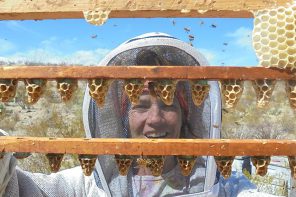By: John Miller
I’ve seen a thing or two. My first visit to the beeyard was in 1960. Back then, we did things the way we did because that’s the way my grandfather did things, which was the way my great-grandfather did things. How little I knew of what the future held for beekeeping.
We have myths in the art of beekeeping. In an effort to write with you, not write to you this month, please share your top beekeeping myth(s) with me.
Some myths are stunners. February 9, 2023 I was working bees in an almond orchard near Woodland, CA. Pulled up a center frame from a fair, but not great hive. Smiling at me, on the same side of the same frame – two queens. I know. I know! Another myth bites the dust.
Here is a myth that rocked my world in about 1978 or so. We made divisions or splits, or nucs each Spring to make up Winter loses. Nothing new there. How we made those nucs was nearly a century-old model.
We set out the parent yard. Set out the covers, bottoms, hive bodies, foundation (the hand-wired 7-S real beeswax foundation that so easily shattered when dropped on crisp Spring mornings). We nailed on bottom boards. Each beekeeper carried a hammer, unless we lost a hammer – then we shared; and half enough feeders for the number of hives we ran.
Feeders were constructed of tempered Masonite and laboriously cut ears, end cuts and bottom cuts. The feeders were sealed by pouring a hefty eighth-cup of liquid beeswax into the feeder. Now roll the wax throughout the interior of the feeder – seal the feeder against leaks. At least that was the idea.
The ‘ears’ on these feeders were notoriously easy to break. The feeders leaked, warped and we had half enough feeders for the number of bees we operated. Even now, 45 years and a couple of chronic sore shoulders removed from the ‘old way’ of making nucs this is stupid painful to rehearse.
This meant that every two weeks or so in Spring, before the dandelion, or between the dandelion and alfalfa bloom – we had to pull and shove hundreds of feeders in an inelegant race to avoid starving beehives. Plastic feeders did not exist. Feed is not expensive until denied.
We hauled syrup in a 300-gallon tank, with a two inch gate valve. We filled most of a five-gallon can with syrup. We then poured the syrup into the Masonite feeder. That was the idea. On windy days – some of the syrup made it into the feeder. This was before the invention of syrup pumps.
Back to the old way of making divides: the beekeeping crew arrived in the parent yard. We had one-third enough pallets at the time, and one (1) 600 model Bobcat skid-steer loader with the Clark brand mast. Not the 12’ mast; the 10’ mast. Any nuc made had to be hand-loaded onto the truck once the parent yard was nuced. Not only was the nuc hand-loaded, each nuc had an entrance screen (think screen door screen) shoved into the entrance to prevent drift. We moved the nucs to a two-mile distant nuc yard, [MYTH ALERT!] where the screens were pulled from the nuc entrance so the nuc did not suffocate, and later, virgin queens could take their flights. We usually pulled almost all the screens. We could sometimes make 250 nucs per day. It was exhausting.
I attended an American Beekeeping Federation convention around that time, and sat next to Dick Ruby, from Milnor, North Dakota. Dick Ruby is a gentleman beekeeper and a smart guy. We were talking about Spring splits. As I described our process, I could see his jaw slacken. When Dick makes an exclamatory remark, it is usually, “Oh, my”.
He asked why we screened, loaded and moved nucs from the parent yard to the nuc yard?
I rehearsed the myth that a beehive must be moved two miles from the parent hive to prevent the bees from abandoning the newly made nuc; drifting back to the parent.
His response was, “No you don’t. Here’s what you do. Make your splits in a 360-degree pattern surrounding where the four parent hives sat on the pallet. Upon finishing the pallet, pick up the pallet and take it away. Leave no trace of familiarity for the foraging bees. Don’t worry about the young, dumb bees. They will stay with the brood in each nuc.”
A myth busted. A back-breaking waste of time, talent and energy schlepping beehives in screened entrances several miles distant from a parent yard to a nuc yard.
The changes were immediate and measurable. The bees drifted some – sometimes. But those young bees always stuck with the brood, keeping it warm and fed. Foragers sort of equalized themselves between the sometimes eight nucs. Sometimes, if the bees were really good, 12 nucs surrounded where the parent pallet of four hives had been.
The myth blown up changed our productivity.
I’ll always be thankful for the gentleman – Dick Ruby – who took the time to help another beekeeper.
That’s one busted myth.
What is your busted beek myth? What are the consequences of the busted myths?
Please share with jerry@beeculture.com – and me: john@millerhoneyfarms.com. Really looking forward to readers’ busted myths.
We can post the busted myths. Letters to “Busted” will be better managed by Editor Hayes.
JRM







